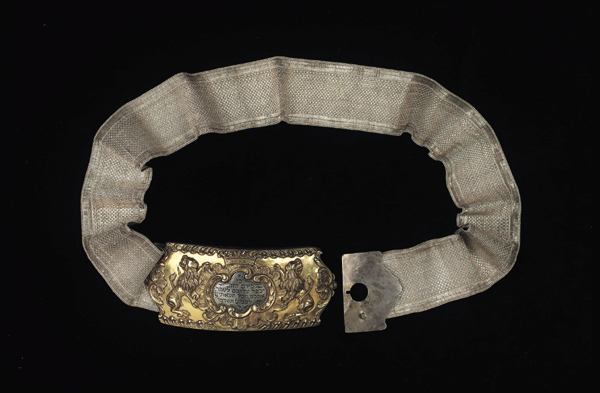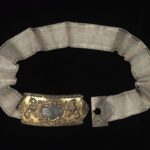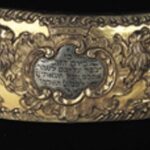Yom Kippur Belt and Buckle
- What do you see?
We can see a satin belt with a silver belt buckle. There are two lions and a crown engraved on the buckle. The inscription in the centre of the buckle is in Hebrew.
Look closely, what can you see?
- What do we know?
We know that this is a belt worn during the festival Yom Kippur, also known as the Day of Atonement. In Judaism, Yom Kippur is celebrated on the last day of Rosh Hashanah, the Jewish New Year. It is a day meant for repentance and fasting. Traditionally, on Yom Kippur and other Jewish holy days, Orthodox Jewish men wear a white robe (kittel) during synagogue services to symbolize purity from sin (Conservative and Reform communities may also choose to wear the kittel).
Although traditions vary from congregation to congregation, Jewish people tend not to wear anything that signifies wealth such as jewellery or leather on Yom Kippur. This is to show that all people are equal under God. However, in the 18th century, it became customary to adorn the robe with a belt and silver buckle, instead of a rope, in Eastern Europe. As we see with this belt, the buckles are typically decorated with lions or eagles along with other ornate details such as a crown. They are also engraved in Hebrew with the Day of Atonement prayer.
Dated to 1790, this Yom Kippur belt was brought to England from Ukraine via Austria. Rabbi Jeffrey F. Gale of the Southend and District Reform Synagogue in Essex originally owned it.
- What do we wonder?
Why are lions and eagles usually depicted on the buckles?
Why did it become customary to wear a belt with a silver buckle instead of a rope?
What might you wonder?
- Object File
Object Name: Yom Kippur Belt and Buckle
Date: 1790
Catalogue number: C 1981.4.13.3
Size (cm): (Buckle) Height: 7.1 cm / (Buckle) Width: 16.9 cm / (Belt incl. clasp) Length: 82.4 cm
Material: Silver, niello, cloth
Celebrated in autumn, Yom Kippur, or the Day of Atonement, is believed to be the day that God closes the Book of Life to begin the start of the New Year. The Book of Life is used by God to decide whether a person has done enough good deeds to have a good New Year. Instead of attending work, most Jewish people will fast on Yom Kippur for 25 hours and go to the synagogue to pray and ask for forgiveness for any sins.
The Day of Atonement prayer is this:
“For on this day shall atonement be made for you, to cleanse you from all your sins, before the Lord you shall be clean” (Leviticus 16.30).


